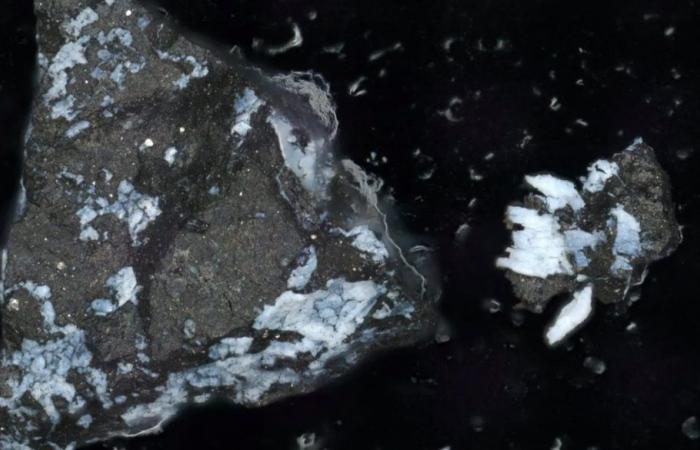A microscopic image of a dark particle from Bennu, about a millimeter long, with a shiny phosphate crust. To the right is a smaller fragment that broke off. – LAURETTA & CONNOLLY ET AL. (2024)
MADRID, June 27 (EUROPA PRESS) –
Magnesium sodium phosphate found in samples brought back from Bennu suggests this asteroid could have broken away from an ancient, small, primitive ocean world.
The first analyses of samples returned to Earth by NASA’s OSIRIS-REx mission have revealed dust rich in carbon, nitrogen and organic compounds — all essential building blocks for life as we know it.
The sample analyzed, dominated by clay minerals, particularly serpentine, reflects the type of rock found at the Earth’s oceanic ridges, according to the research, published in the journal Meteoritics & Planetary Science.
As for phosphate, it was a surprise to the team because the mineral had not been detected by the OSIRIS-REx spacecraft while it was on Bennu.
While a similar phosphate was found in the Ryugu asteroid sample returned by JAXA’s Hayabusa2 mission in 2020, the sodium magnesium phosphate detected in the Bennu sample stands out for its purity (i.e., lack of other materials included in the mineral) and the size of its grains, something unprecedented in any meteorite sample.
The discovery of magnesium and sodium phosphates in the Bennu sample raises questions about the geochemical processes that concentrated these elements and provides valuable clues about Bennu’s historical conditions.
“The presence and state of phosphates, along with other elements and compounds on Bennu, suggest a watery past for the asteroid,” he said. it’s a statement Dante Lauretta, co-senior author of the paper and principal investigator of OSIRIS-REx at the University of Arizona, Tucson. “Bennu could have been part of a wetter world. Although this hypothesis requires more research.”
“OSIRIS-REx gave us exactly what we expected: a large pristine nitrogen- and carbon-rich asteroid sample from a formerly wet world“said Jason Dworkin, a co-author on the paper and OSIRIS-REx project scientist at NASA’s Goddard Space Flight Center.
The team has confirmed that the asteroid is rich in carbon and nitrogen. These elements are crucial to understanding the environments in which Bennu’s materials originated and the chemical processes that transformed simple elements into complex molecules, potentially laying the foundation for life on Earth.
“These findings underscore the importance of collecting and studying material from asteroids like Bennu, especially low-density material that would normally burn up upon entering Earth’s atmosphere,” Lauretta said. “This material is the key to unraveling the intricate processes of solar system formation and the prebiotic chemistry that could have contributed to the emergence of life on Earth.”






